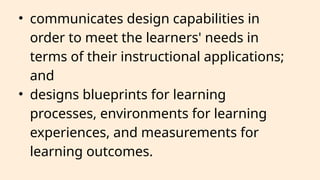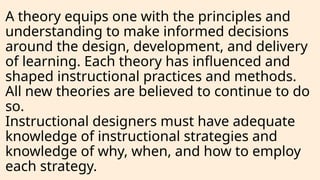HISTORY AND EVOLUTION OF INSTRUCTIONAL DESIGN
- 1. HISTORY AND EVOLUTION OF INSTRUCTIONAL DESIGN HISTORY AND EVOLUTION OF INSTRUCTIONAL DESIGN
- 4. B. F. Skinner’s article "The Science of Learning and the Art of Teaching" guided educators in instructional planning. Benjamin Bloom developed the "Taxonomy of Educational Objectives."
- 6. -described three domains of learning outcomes (cognitive, affective, and psychomotor), five learning outcomes (verbal information, intellectual skills, cognitive strategy, attitude, and motor skills), and nine events of instruction in research called "The Conditions of Learning." 2. Robert Gagne (1965)
- 7. 3. Several instructional models emerged that are based on systems information processing and were developed across the military, academia, and organizations. • Information-processing approach -Models used media and instructional design procedures to improve the quality of instruction.
- 8. -developed the Component Display Theory (CDT), which focused on the methods of presenting instructional materials. There was also a rising interest in the principles of cognitive psychology. 4. David Merrill
- 9. 5. The influence of constructivist theory within the field of instructional design became more active in the 1990s. Constructivists stated that learning should be "authentic" and produce real- world learning experiences that allow the learner to form and construct their own knowledge.
- 10. 6. Performance improvement, performance support, and rapid prototyping were fast-growing trends in the nineties.
- 11. 7. Computer-Based Training (CBT) delivered via CD-ROM became a common vehicle to deliver interactive training. Developed by David Merrill
- 12. 8. With improved Internet penetration, online learning or elearning became much more prevalent in the corporate sector. Companies started using online learning for onboarding new employees and developing new skills. Rich instructional media, including video and simulations, became possible as internet bandwidth improved.
- 13. 9. The infusion of smartphones and tablets into corporations and homes stimulated the mobile and social learning in the industry. Blended learning, a combination of face-to-face and online learning, was commonly used both in education and the industry to
- 14. 10. Today, Instructional materials are much more personalized and targeted as a result of the "Big Data" and analytics. The focus is not just on the learning outcomes, but also on the overall user experience of the learner. This approach has given rise to the Learner Experience (LX) Design, which focuses on the process of creating learning experiences that enable the learner to achieve the desired learning outcome in a human-centered and goal-oriented way.
- 16. The teacher assumes varied roles inside the classroom, such as the facilitator, instructional designer, assessor, coach, and planner. His or her role as an instructional designer is as equally important as the rest. As an instructional designer, the teacher performs these tasks:
- 17. • analyzes the learner, context, and situation; • applies learning theories and instructional system; • design models, instructional theories, and design communications to solve learning and performance problems; • designs and develops instructional materials for instructional training and educational applications;
- 18. • communicates design capabilities in order to meet the learners' needs in terms of their instructional applications; and • designs blueprints for learning processes, environments for learning experiences, and measurements for learning outcomes.
- 20. Theory guides instructional design and instructional practices. Our own practices are also driven by our conceptions and theories about learning and teaching. Learning theories help educators and instructional designers to understand how people learn.
- 21. A theory equips one with the principles and understanding to make informed decisions around the design, development, and delivery of learning. Each theory has influenced and shaped instructional practices and methods. All new theories are believed to continue to do so. Instructional designers must have adequate knowledge of instructional strategies and knowledge of why, when, and how to employ each strategy.
- 22. Instructional theories originate from learning research and theory. instructional design theories provide guidelines for educators. These theories transform descriptive theory into methods of how to work, how to develop techniques, and how to determine implementation details that are applicable to most conditions
- 23. Regeluth (1999) described four major characteristics of instructional design theory: 1. It is design-oriented. It focuses on means to attain given goals for learning or development as it provides direct guidance on how to achieve their goals. 2. it identifies methods of instruction which refer to the ways to support and facilitate learning, and the situations in which those methods should be used.
- 25. 3. The methods of instruction can be broken into more detailed component methods, which provide more guidance to educators about different elements and ways to perform the methods. 4. Instructional design theories intend to control variables in the learning environment to achieve certain results.
- 26. There are two major components in instructional design theory: 1. Methods of instruction-methods for facilitating human learning and development 2. Instructional situation - indications as to when and when not to use those methods and descriptions of the conditions under which the instruction will take place

























